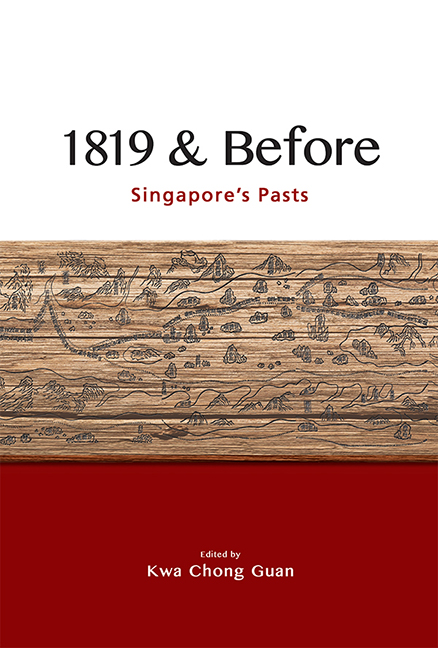Book contents
- Frontmatter
- Contents
- Foreword
- Acknowledgments
- Contributors
- 1 Introduction: Approaches to Singapore’s Past before 1819
- 2 Issues and Approaches to Studying Singapore before 1819
- 3 Regional Influences, International Geopolitics and Environmental Factors in the Rise and Demise of Temasek
- 4 The Mysterious Malay Jong and Other Temasek Shipping
- 5 The Orang Laut and the Negara Selat (Realm of the Straits)
- 6 Avoidance of Shipwreck in the Malay Annals: A Trope in Buddhist Narratives of Maritime Crossings
- 7 The Inception of Lion City
- 8 A Note on Amoghapāśa-Lokeśvara in Singapura
- 9 Portuguese and Dutch Records for Singapore before 1819: An Overview
- 10 Zheng He’s Navigation Methods and His Visit to Longyamen, Singapore
- Bibliography
- Index
4 - The Mysterious Malay Jong and Other Temasek Shipping
Published online by Cambridge University Press: 09 October 2021
- Frontmatter
- Contents
- Foreword
- Acknowledgments
- Contributors
- 1 Introduction: Approaches to Singapore’s Past before 1819
- 2 Issues and Approaches to Studying Singapore before 1819
- 3 Regional Influences, International Geopolitics and Environmental Factors in the Rise and Demise of Temasek
- 4 The Mysterious Malay Jong and Other Temasek Shipping
- 5 The Orang Laut and the Negara Selat (Realm of the Straits)
- 6 Avoidance of Shipwreck in the Malay Annals: A Trope in Buddhist Narratives of Maritime Crossings
- 7 The Inception of Lion City
- 8 A Note on Amoghapāśa-Lokeśvara in Singapura
- 9 Portuguese and Dutch Records for Singapore before 1819: An Overview
- 10 Zheng He’s Navigation Methods and His Visit to Longyamen, Singapore
- Bibliography
- Index
Summary
With no reported shipwrecks in Singapore waters, we must draw on archaeological evidence from surrounding seas along with historical sources to investigate the wide range of ships that once called here. Apart from the European square riggers, it turns out that the eclectic mix of vessels anchored off the Singapore River during Raffles's early years, as depicted in paintings held in the National Museum (fig. 4.1), would not have differed much from the shipping of five centuries earlier. While numbers and makeup fluctuated with Singapore's changing status and with developments far afield, the diversity of shipping would have been maintained beyond fourteenth-century Temasek to at least the end of the seventeenth century.
Perhaps the earliest relevant archaeological discovery within this defined pre-colonial period is the Nipa Shoal Wreck. Nipa Shoal lies less than ten kilometres to the west of Raffles Lighthouse, within Indonesian territorial waters. The original finder, Warren Blake, donated most of the recovered artefacts to the National Museum. They include Longquan celadon dishes, stoneware jars and thousands of Chinese copper coins, the most recent providing an earliest possible wrecking date of 1258. The oldest coin dates to 762, illustrating the remarkable longevity of Chinese coin utilization, and implying that the actual wrecking date could be decades after 1258; the Longquan celedon suggests the late thirteenth century or beyond. Unfortunately, no hull remains were found. It is impossible to determine whether this ship had traded at the fledgling Temasek port before running afoul of the rocks as she journeyed further west. If she did, it is perhaps more likely that she was a Southeast Asian ship involved in the entrepôt trade. If she did not, she could have been a Chinese junk transiting the Singapore Strait during the northeast monsoon.
The Jade Dragon Wreck sank around the same time as the Nipa Shoal Wreck and with the same type of cargo, but off the northernmost tip of Borneo. Unfortunately, the site was looted before archaeological intervention; however, hull remains confirm that the ship was of the Southeast Asian lashed-lug tradition. Planks were carved to shape and incorporated perforated lugs to which frames were lashed with ijok(sugar palm fibre).
- Type
- Chapter
- Information
- 1819 & BeforeSingapore's Pasts, pp. 35 - 44Publisher: ISEAS–Yusof Ishak InstitutePrint publication year: 2021

